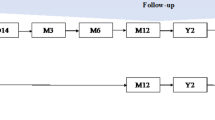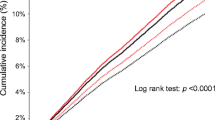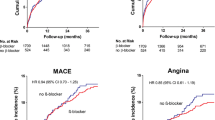Abstract
We assessed the independent effects of beta blockers, calcium antagonists, lipid-lowering drugs, angiotensin converting enzyme inhibitors (ACEIs), angiotensin receptor blockers (ARBs), anti-platelet drugs, vitamin K antagonists, percutaneous coronary intervention (PCI) and coronary artery by-pass grafting (CABG) on mortality and on the composite endpoint of death, myocardial infarction, stroke or heart failure in patients with stable angina pectoris. We estimated the effects of the interventions used at baseline by multivariate Cox regression and during follow-up by G-estimation in 7,665 patients followed for a mean of 5 years in the ACTION trial. Adjusted hazard ratios (95% confidence intervals) comparing all cause mortality among users during follow-up to non-users were 1.01 (0.91, 1.09) for beta blockade, 0.82 (0.75, 0.89) for ACEIs or ARBs, 0.93 (0.87, 0.98) for calcium antagonists, 0.54 (0.49, 0.62) for lipid-lowering drugs, 0.49 (0.42, 0.53) for anti-platelet drugs, 0.74 (0.69, 0.78) for PCI, and 0.91 (0.82, 0.98) for CABG. Effects on the composite endpoint were less marked. This observational study confirms that ACEIs or ARBs, lipid-lowering and anti-platelet drugs as used in the everyday management of stable angina have independent secondary preventive effects. Calcium antagonists, PCI and CABG also appear to improve outcome.
Similar content being viewed by others
Abbreviations
- ACEI:
-
Angiotensin converting enzyme inhibitor
- aHR:
-
Adjusted hazard ratio
- ARB:
-
Angiotensin receptor blocker
- ATC:
-
Anatomical therapeutic chemical
- CABG:
-
Coronary artery by-pass grafting
- CEC:
-
Critical events committee
- CI:
-
Confidence interval
- GCP:
-
Good clinical practice
- GITS:
-
Gastrointestinal therapeutic system
- HF:
-
Heart failure
- HR:
-
Hazard ratio
- ICH:
-
International conference on harmonisation
- MI:
-
Myocardial infarction
- PCI:
-
Percutaneous coronary intervention
References
Kjekshus J, Apetrei E, Barrios V, Böhm M, Cleland JG, Cornel JH, Dunselman P, Fonseca C, Goudev A, Grande P, Gullestad L, Hjalmarson A, Hradec J, Jánosi A, Kamenský G, Komajda M, Korewicki J, Kuusi T, Mach F, Mareev V, McMurray JJ, Ranjith N, Schaufelberger M, Vanhaecke J, van Veldhuisen DJ, Waagstein F, Wedel H, Wikstrand J. CORONA Group. Rosuvastatin in older patients with systolic heart failure. N Engl J Med. 2007;357:2248–61.
Poole-Wilson PA, Lubsen J, Kirwan BA, van Dalen FJ, Wagener G, Danchin N, Just H, Fox KA, Pocock SJ, Clayton TC, Motro M, Parker JD, Bourassa MG, Dart AM, Hildebrandt P, Hjalmarson A, Kragten JA, Molhoek GP, Otterstad JE, Seabra-Gomes R, Soler-Soler J, Weber S. Coronary disease Trial Investigating Outcome with Nifedipine gastrointestinal therapeutic system investigators. Effect of long-acting nifedipine on mortality and cardiovascular morbidity in patients with stable angina requiring treatment (ACTION trial): randomised controlled trial. Lancet. 2004;364:849–57.
Lubsen J, Poole-Wilson PA, Pocock SJ, van Dalen FJ, Baumann J, Kirwan BA, Parker AB. Design and current status of ACTION: A Coronary disease Trial Investigating Outcome with Nifedipine GITS. Gastro-Intestinal Therapeutic System. Eur Heart J. 1998;19(I):I20–32.
Management of stable angina pectoris. Recommendations of the Task Force of the European Society of Cardiology. Eur Heart J. 1997;18(3):394–413.
Dalal H, Evans PH, Campbell JL. Recent developments in secondary prevention and cardiac rehabilitation after acute myocardial infarction. Br Med J. 2004;328:693–7.
Fox K, Garcia MA, Ardissino D, Buszman P, Camici PG, Crea F, Daly C, De Backer G, Hjemdahl P, Lopez-Sendon J, Marco J, Morais J, Pepper J, Sechtem U, Simoons M, Thygesen K, Priori SG, Blanc JJ, Budaj A, Camm J, Dean V, Deckers J, Dickstein K, Lekakis J, McGregor K, Metra M, Morais J, Osterspey A, Tamargo J, Zamorano JL. Task Force on the Management of Stable Angina Pectoris of the European Society of Cardiology; ESC Committee for Practice Guidelines (CPG). Guidelines on the management of stable angina pectoris: executive summary: the Task Force on the Management of Stable Angina Pectoris of the European Society of Cardiology. Eur Heart J. 2006;27:1341–81.
Kirwan BA, Lubsen J, Poole-Wilson PA. Treatment of angina pectoris: associations with symptom severity. Int J Cardiol. 2005;98:299–306.
Kirwan BA, Lubsen J, Brouwer S, Danchin N, Battler A, Bayes de Luna A, Dunselman PH, Glasser S, Koudstaal PJ, Sutton G, van Dalen FJ, Poole-Wilson PA. ACTION (A Coronary disease Trial Investigating Outcome with Nifedipine GITS) investigators. Diagnostic criteria and adjudication process both determine published event-rates: The ACTION trial experience. Contemp Clin Trials. 2007;28:720–9.
Mark SD, Robins JM. Estimating the causal effect of smoking cessation in the presence of confounding factors using a rank preserving structural failure time model. Stat Med. 1993;12:1605–28.
Sterne JAC, Tilling K. G-estimation of causal effects, allowing for time-varying confounding. Stata J. 2002;2:164–82.
Filippi A, Gensini G, Bignanimi AA, Sabatini A, Mazzaglia G, Cricelli C. Management of patients with suspected angina, but without known myocardial infarction: a cross-sectional survey. Br J Gen Pract. 2004;54:429–33.
Hemingway H, McCallum A, Shipley M, Manderbacka K, Martikainen P, Keskimaki I. Incidence and prognostic implications of stable angina pectoris among women and men. JAMA. 2006;295:1404–11.
Gibbons RJ, Abrams J, Chatterjee K, Daley J, Deedwania PC, Douglas JS, Ferguson TB Jr, Fihn SD, Fraker TD Jr, Gardin JM, O’Rourke RA, Pasternak RC, Williams SV. American College of Cardiology; American Heart Association Task Force on practice guidelines (Committee on the Management of Patients With Chronic Stable Angina). ACC/AHA 2002 guideline update for the management of patients with chronic stable angina–summary article: a report of the American College of Cardiology/American Heart Association Task Force on practice guidelines (Committee on the Management of Patients With Chronic Stable Angina). J Am Coll Cardiol. 2003;41:159–68.
Daly C, Clemens F, Lopez-Sendon JL, Tavazzi L, Boersma E, Danchin N, Delahaye F, Gitt A, Julian D, Mulcahy D, Ruzyllo W, Thygesen K, Verheugt F. Fox KM; Euro Heart Survey Investigators. The impact of guideline compliant medical therapy on clinical outcome in patients with stable angina: findings from the Euro Heart Survey of stable angina. Eur Heart J. 2006;27:1298–304.
Danchin N, Cambou JP, Hanania G, Kadri Z, Genes N, Lablanche JM, Blanchard D, Vaur L, Clerson P. Guéret P; USIC 2000 investigators. Impact of combined secondary prevention therapy after myocardial infarction: data from a nationwide French registry. Am Heart J. 2005;150:1147–53.
Miettinen OS. The need for randomization in the study of intended effects. Stat Med. 1983;2:267–71.
Hurlen M, Abdelnoor M, Smith P, Erikssen J, Arnesen H. Warfarin, aspirin, or both after myocardial infarction. N Engl J Med. 2002;347:969–74.
Boden WE, O’Rourke RA, Teo KK, Hartigan PM, Maron DJ, Kostuk WJ, et al. Optimal medical therapy with or without PCI for stable coronary disease. N Engl J Med. 2007;356:1503–16.
Acknowledgments
The contribution of investigators, committee members and other study personnel as listed elsewhere is gratefully acknowledged [2], as is the support of Bayer Healthcare AG. Bayer Healthcare AG had no role in the design and conduct of the study; or in the preparation, review and approval of this manuscript.
Conflict of interest
The ACTION trial was funded by Bayer Healthcare AG. S de Brouwer, B-A Kirwan, and J Lubsen were full-time employees of SOCAR Research SA, which managed the study. Z Vokó worked as consultant epidemiologist for SOCAR Research SA. PHJM Dunselman was member of the Critical Events Committee and Nicolas Danchin was Chairman of this committee. JE Otterstad was member of the Steering Committee and one of the country coordinators. Members of committees were funded by SOCAR Research SA to attend meetings related to the trial. Z Vokó, N Danchin, JE Otterstad, PHJM Dunselman, J Lubsen have served as consultants to or received travel expenses, or funding for research from other pharmaceutical companies.
Author information
Authors and Affiliations
Corresponding author
Rights and permissions
About this article
Cite this article
Vokó, Z., de Brouwer, S., Lubsen, J. et al. Long-term impact of secondary preventive treatments in patients with stable angina. Eur J Epidemiol 26, 375–383 (2011). https://doi.org/10.1007/s10654-011-9558-5
Received:
Accepted:
Published:
Issue Date:
DOI: https://doi.org/10.1007/s10654-011-9558-5




